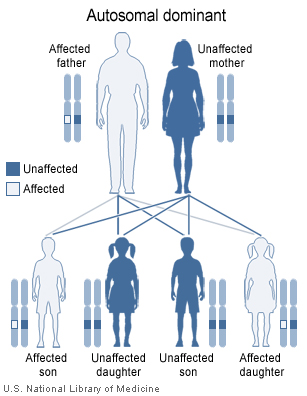Von Willebrand disease pathophysiology: Difference between revisions
Prince Djan (talk | contribs) |
|||
| Line 19: | Line 19: | ||
|-valign="top" | |-valign="top" | ||
|[[Image:autodominant.jpg|thumb|von Willebrand disease types I and II are inherited in an [[autosomal dominant]] pattern.]] | |[[Image:autodominant.jpg|thumb|von Willebrand disease types I and II are inherited in an [[autosomal dominant]] pattern.]] | ||
|} | |} | ||
Revision as of 15:23, 28 November 2016
|
Von Willebrand disease Microchapters |
|
Diagnosis |
|---|
|
Treatment |
|
Case Studies |
|
Von Willebrand disease pathophysiology On the Web |
|
American Roentgen Ray Society Images of Von Willebrand disease pathophysiology |
|
Risk calculators and risk factors for Von Willebrand disease pathophysiology |
Editor-In-Chief: C. Michael Gibson, M.S., M.D. [1]
Overview
Pathophysiology
vWF is mainly active in conditions of high blood flow and shear stress. Deficiency of vWF therefore shows primarily in organs with extensive small vessels, such as the skin, the gastrointestinal tract and the uterus. In angiodysplasia, a form of telangiectasia of the colon, shear stress is much higher than in average capillaries, and the risk of bleeding is increased concomitantly.
In more severe cases of type 1 vWD, genetic changes are common within the vWF gene and are highly penetrant. In milder cases of type 1 vWD there may be a complex spectrum of molecular pathology in addition to polymorphisms of the vWF gene alone.[1] The individual's ABO blood group can influence presentation and pathology of vWD. Those individuals with blood group O have a lower mean level than individuals with other blood groups. Unless ABO group–specific vWF:antigen reference ranges are used, normal group O individuals can be diagnosed as type I vWD, and some individuals of blood group AB with a genetic defect of vWF may have the diagnosis overlooked because vWF levels are elevated due to blood group.[2]
Genetics
 |
The vWF gene is located on chromosome twelve (12p13.2). It has 52 exons spanning 178kbp. Types 1 and 2 are inherited as autosomal dominant traits and type 3 is inherited as autosomal recessive. Occasionally type 2 also inherits recessively.
References
- ↑ James P, Notley C, Hegadorn C, Leggo J, Tuttle A, Tinlin S, Brown C, Andrews C, Labelle A, Chirinian Y, O'Brien L, Othman M, Rivard G, Rapson D, Hough C, Lillicrap D (2007). "The mutational spectrum of type 1 von Willebrand disease: Results from a Canadian cohort study". Blood. 109 (1): 145–54. doi:10.1182/blood-2006-05-021105. PMID 17190853.
- ↑ Gill, JC (1987). "The effect of ABO blood group on the diagnosis of von Willebrand disease". Blood. 69 (6): 1691–5. PMID 3495304. Unknown parameter
|coauthors=ignored (help)